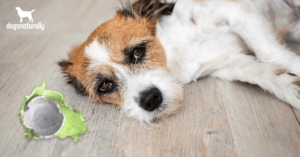Poison ivy, a common plant found in many natural or wooded areas, or even in your own backyard, is well known to cause skin irritation in humans. But how does poison ivy impact dogs?
In this post we’ll explore the effects of poison ivy on dogs, what to look for, and how to treat it.
Can Dogs Get Poison Ivy?
The simple answer is yes, dogs can get poison ivy. But generally speaking, dogs are less sensitive to allergic reactions to this plant than humans. It’s rare for them to get the irritation and itching from poison ivy that humans experience, but it can and does happen.
Dogs’ fur provides an extra layer of protection against the plant’s irritating oil, urushiol … which is what’s responsible for poison ivy’s infamous allergic reaction.
That said, if the oil does come in contact with your dog’s skin, it can still cause a reaction, especially in areas with thin fur, such as the belly, face, or paws.
Also, some dogs are more sensitive to poison ivy than others. Dogs with skin allergies or certain breeds with sensitive skin may be more prone to react to poison ivy’s effects.
What Does Poison Ivy Look Like On A Dog?
Dog poison ivy symptoms are pretty similar to how poison ivy looks on humans. That means things like skin redness, swelling, and small bumps or blisters on the skin.
Again, these symptoms can occur anywhere on the body, but they’re most commonly seen on thinly furred or hairless areas.
You might first notice poison ivy on dogs because your dog will likely scratch or bite at the affected areas. While this can be a helpful tip-off that there’s a problem, it can also potentially lead to secondary infections or more severe skin issues. So it’s important to treat poison ivy on dogs before your pup does too much scratching.
In some cases, dogs may not show any visible signs of a reaction but may transfer the urushiol oil to their owners through their fur, leading to skin irritation in humans. This means that petting or cuddling with a dog that has recently come into contact with poison ivy can transfer the oil to your skin, causing you to experience the itchy rash yourself.
Poison Ivy Rash On Dogs: What Are The Symptoms?
To recap, the symptoms of poison ivy exposure in dogs may vary depending on the severity of the reaction and the extent of skin contact, but the most common symptoms include:
- Skin redness
- Swelling
- Itchy or inflamed skin
- Small bumps or blisters
- Scratching or biting at affected areas
If your dog shows any of these symptoms after coming into contact with poison ivy, it’s essential to seek treatment promptly to relieve discomfort and prevent more severe complications.
How Long Does Poison Ivy Oil Last On Dog Fur?
Urushiol oil, the substance responsible for poison ivy reactions, can remain active on a dog’s fur for several days to weeks after contact. During this time, it can be easily transferred to other surfaces, including human skin, clothing, furniture, and bedding.
That’s why it’s essential to thoroughly wash your dog and any items he may have come into contact with after exposure to poison ivy. Let’s look at how to do that now.
How To Treat Poison Ivy On Dogs
If you think your dog may have been exposed to poison ivy, here are some steps you can take to minimize their discomfort and prevent the spread of urushiol oil. Getting rid of the oil is a priority.
- Give homeopathic remedies quickly if you notice your dog has a poison ivy rash or signs of an allergic reaction. See below for the best remedies for poison ivy, depending on symptoms.
- Remove the oil: As soon as you can, bathe your dog in cool water with a natural shampoo, making sure to lather well and thoroughly wash any areas that may have come into contact with the plant. Wear gloves to protect yourself from getting the oil on your skin. Pay particular attention to areas where your dog has less fur, as these will be extra vulnerable to poison ivy.
- Apply topical treatments: Topical treatments that may soothe poison ivy rash include cool compresses, calendula cream or tincture, apple cider vinegar, pure aloe vera, or chamomile tea. Some people swear by Bentonite clay because of its drying effect, especially if the rash is oozy. You can make a paste of clay and water, and apply to the itchy areas, then rinse off and reapply as needed, .
- Prevent scratching: If your dog is scratching or biting at the affected areas, you may need to use a cone, medical protective clothing or even put an old t-shirt on your dog, to prevent further damage to his skin.
- Clean contaminated items: Wash your dog’s bedding, toys, leash, and collar to remove any remaining urushiol oil. This will prevent the oil from coming into contact with you or your dog.
- Ask your holistic veterinarian: If your dog’s symptoms are severe or persistent, you may want to ask your holistic vet for help with treatment.
Homeopathic Remedies For Poison Ivy
If your dog gets a rash or skin reaction from his contact with poison ivy, homeopathy can help. The first remedy most people suggest for poison ivy is Rhus toxicodendron (Rhux tox), because it’s made from the poison ivy plant. But there are other remedies that can be a better fit, based on your dog’s symptoms, so start with the remedy that best fits the descriptions below.
- Rhus toxicodendron: Restless or irritable, heat or hot water relieves discomfort, symptoms are better with movement.
- Anarcardium orientale: Intensely itchy redness and rash. Warmth and scratching aggravate the itching, Symptoms may be worse on left side, or at night. Yellowish discharge.
- Croton tiglium: Rash with blisters, often around the face or groin. Yellow oozing that forms scabs. May be worse at night and on left side.
- Graphites: Honey-like yellowish discharge, crusty skin.
- Sulphur: Scratching causes bleeding which relieves the itching. Yellow or white discharge. Bathing causes further irritation.
How To Dose
Use a 30C (or lower) potency and dose every 15 minutes for the first hour, then once an hour for 2 hours … or until you see a response. Stop dosing when symptoms ease, and only redose (once) when your dog backslides or plateaus. Switch remedies if there’s no relief in the first 2-3 hours.
RELATED: For more detailed dosing instructions, refer to Homeopathy Basics For Dogs …
Poison Ivy On Dogs | Bottom Line
Although dogs are less susceptible to poison ivy reactions than humans, they can still experience skin irritation from the plant, especially in areas where they don’t have as much fur. And if the urushiol oil is on their fur, you can get it on your own skin and develop symptoms.
But now that you know how to recognize and treat the signs of poison ivy on dogs, you can help keep your pup happy and healthy no matter what.












